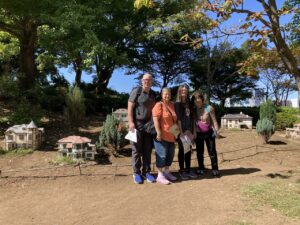
Date & Time: Friday, 6 October, 10:00 a.m. – 3:30 p.m.
Visitors: Four Americans, including John, Vicki (his wife), Alyssa (their niece), and John Jr. (their son) who joined along the way.
Spots: Yokohama Motomachi, Yamate area, Yokohama Chinatown, and Yokohama Doll Museum
Guides: Two KSGG members, Michiko & Noriko
Language: English
The first leg of this tour was the area of Yokohama Yamate Western-style old buildings in a former foreign settlement, deeply connected to the history of the opening of Yokohama Port. These buildings convey the lifestyle of old days, and a lot of tourists visit there for retro-cool and fancy airs. There are a total of seven buildings open to the public without reservation or charge.
It was the finest and most comfortable day ever, one of the attendants supposed. The three Americans started to walk around the Yamate area. Their great love for animals was extremely surprising to the attendants. Anytime they came across a dog, they unexceptionally patted its head, held its paws, and hugged it. Every dog laid on its back pleasantly. Their activities seemed to be a most ideal type of communication without the use of language.
When John went to the Bluff 80 Memorial Terrace, the remains of a residence ruined by the Great Kanto Earthquake in 1923, he talked to us about the experience of the Great East Japan Earthquake in 2011 during which he was staying in Kyoto. The memorial terrace is behind Ehrismann Residence, one of the seven buildings.
The tour group had lunch at a vegetarian restaurant in Yokohama Chinatown for animal loving Alyssa was reluctant to eat meat.
Next spot of the tour after lunch was Yokohama Doll Museum, which houses a collection of more than 10,000 dolls from over 100 countries and territories, and you feel like cruising to explore dolls worldwide in the museum. It was unexpected that the museum was the place where the tourists took photos most. They looked fascinated by sophisticated Japanese dolls made in old days from the 17th century to the 19th century.
Then John Jr. joined the tour outside the museum. When John Jr. was asked why he had signed up for the tour of the Yamate Western-style old buildings area, he replied that he wanted his parents to understand a traditional Japanese culture as well as a westernized culture in Japan after the Meiji period. And he said, “I came to Japan to study at a Japanese university 10 years ago, and I am now teaching English in Japan. I have been engaged to a Japanese woman.”
The visitors were warm-hearted, and the attendants had amusing conversations. One of the attendants expressed the impression that this guide experience gave them good tips on how to guide foreigners around the Yamate area.
